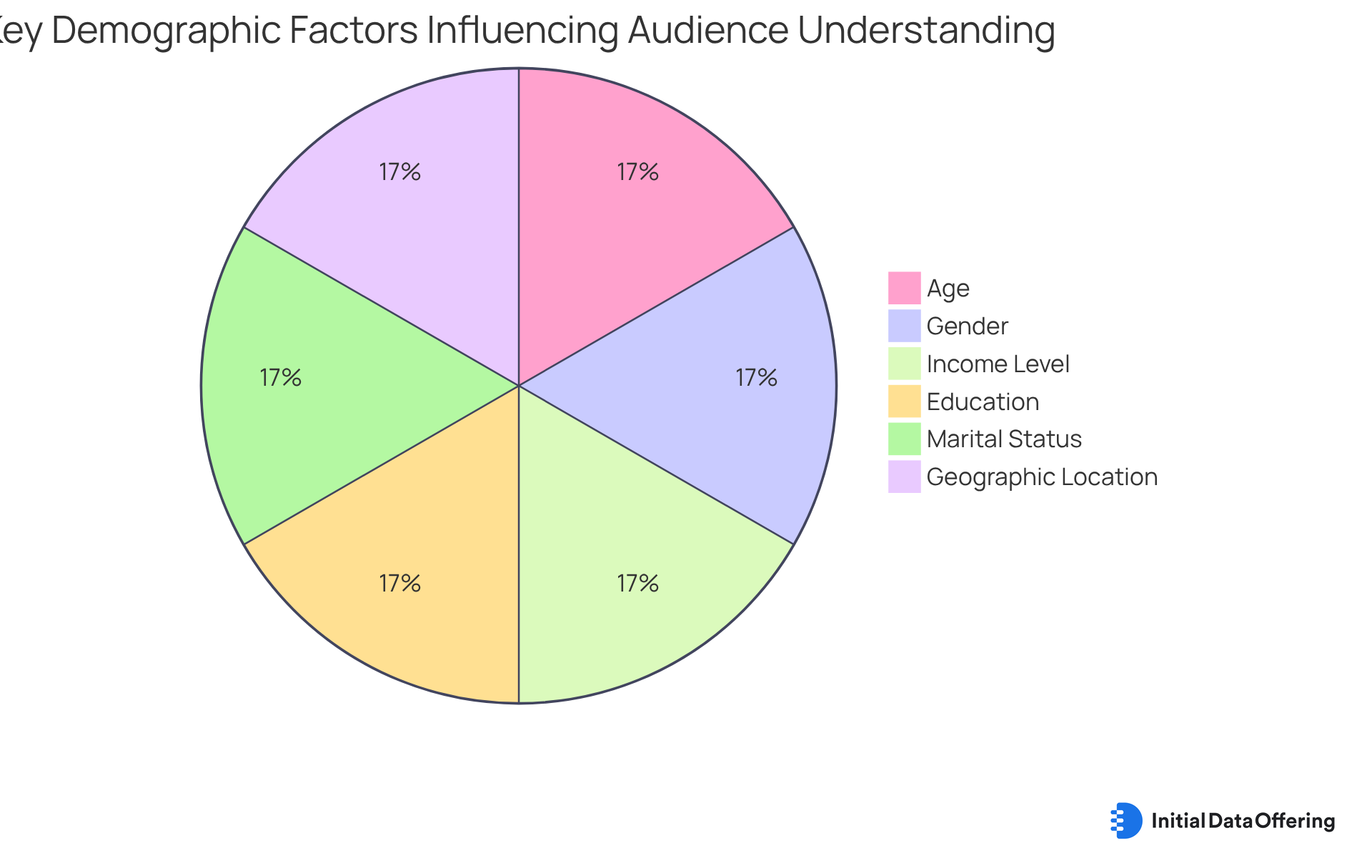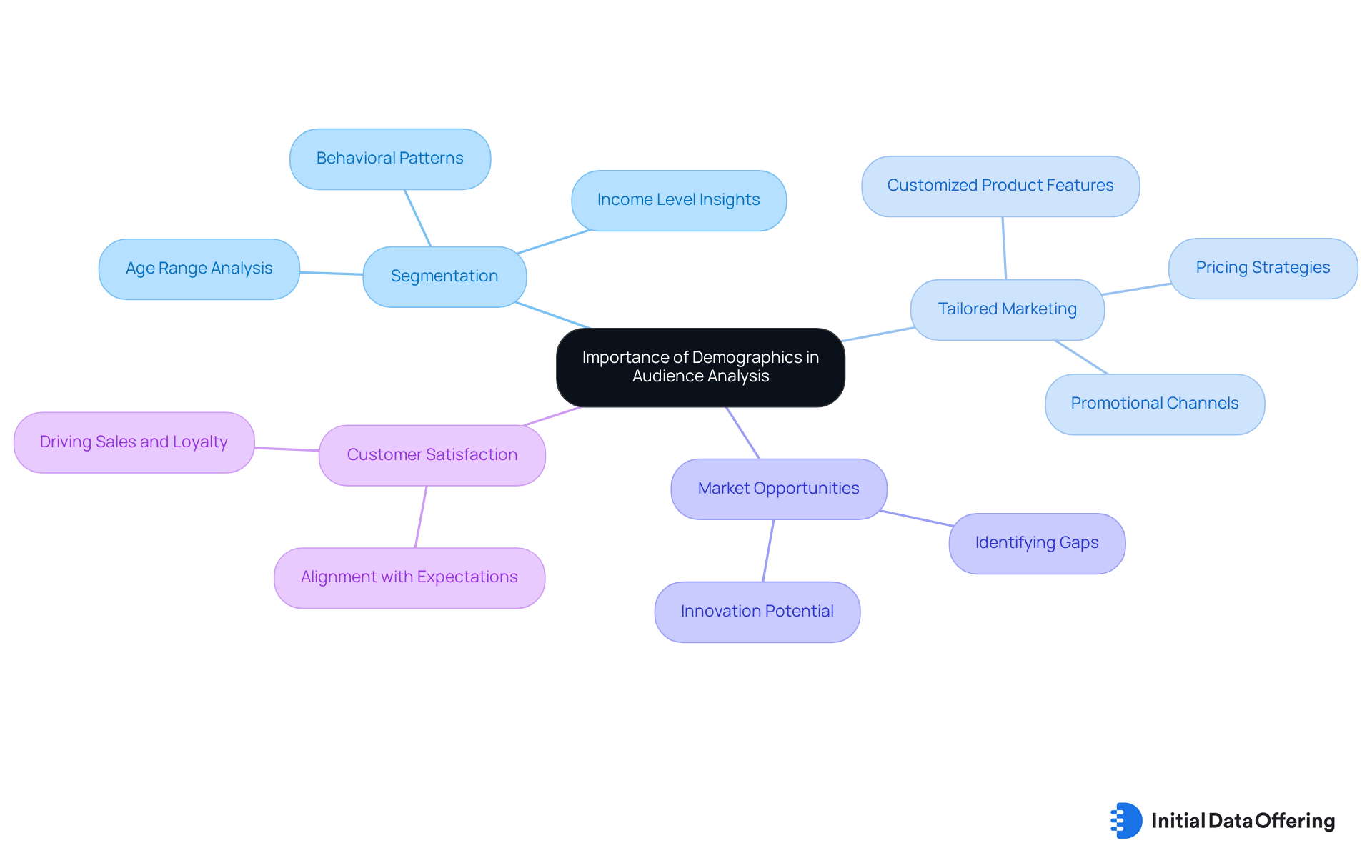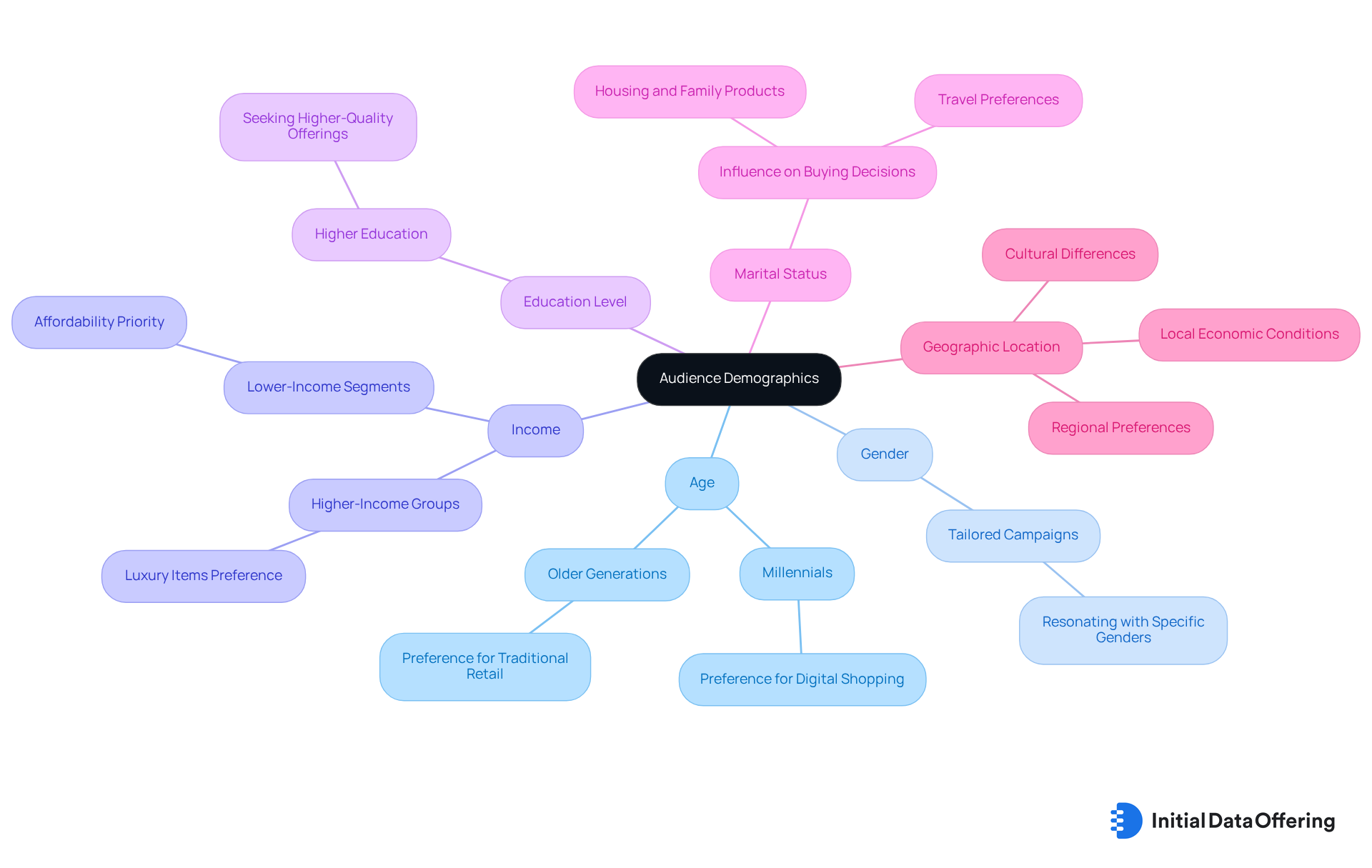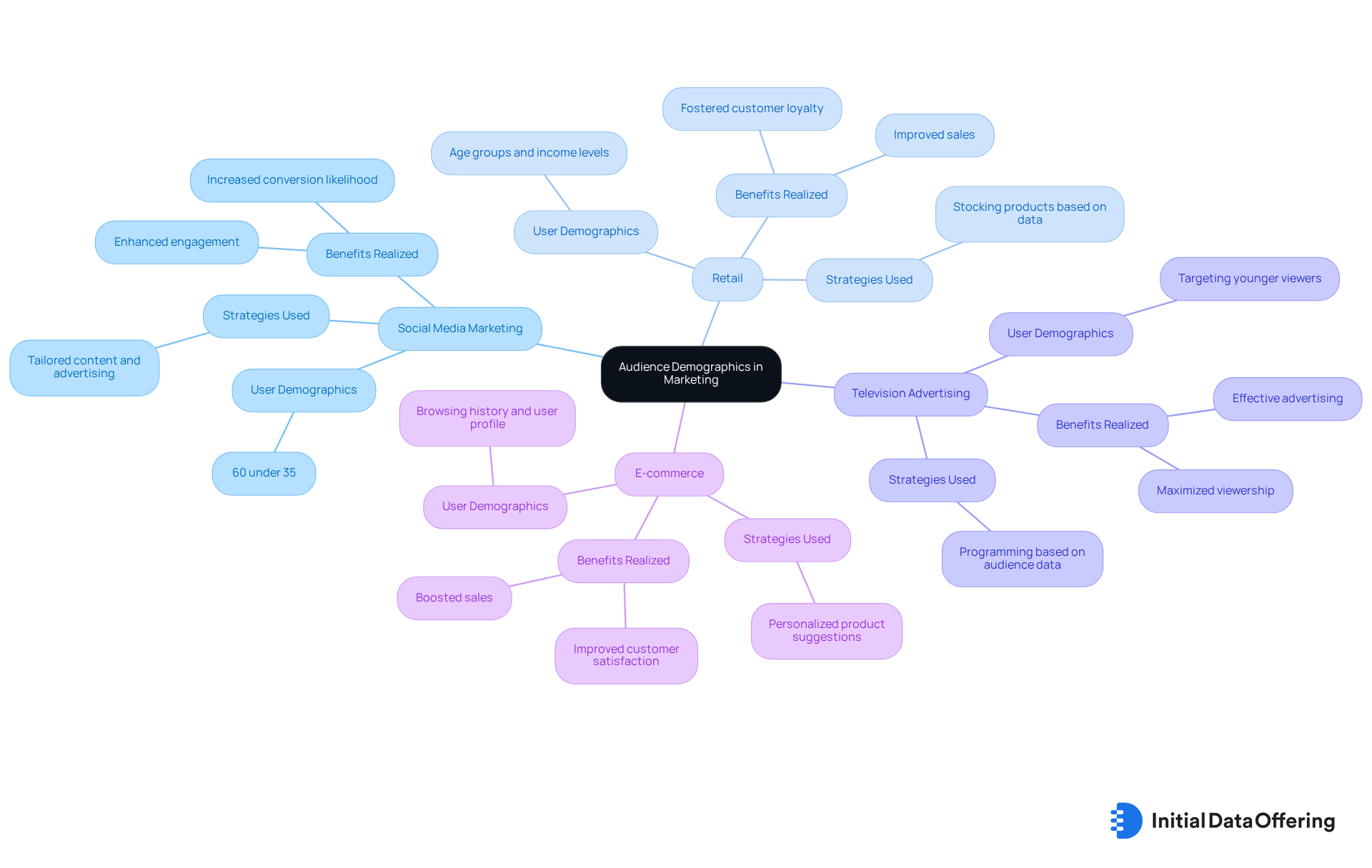Understanding the Demographics of an Audience: Key Components and Examples

Understanding the Demographics of an Audience: Key Components and Examples
Overview
The article centers on the importance of understanding audience demographics, which encompass essential components such as:
- Age
- Gender
- Income
- Education
- Marital status
- Geographic location
By analyzing these demographic factors, businesses can effectively tailor their marketing strategies. For instance, industries like social media, retail, and e-commerce showcase how targeted approaches can lead to enhanced customer engagement and increased sales. How might these insights inform your marketing efforts? Ultimately, recognizing the significance of demographics not only aids in strategy development but also fosters a deeper connection with the audience.
Introduction
Understanding the demographics of an audience is crucial in today’s competitive landscape, where tailored marketing strategies can significantly influence a brand's success. By examining key characteristics such as age, gender, income, and geographic location, businesses can unlock powerful insights that enhance consumer engagement and satisfaction. These insights not only allow for targeted messaging but also foster a deeper connection with diverse audience segments.
However, the challenge lies in effectively leveraging this demographic data to create strategies that resonate with these varied groups. What innovative approaches can marketers adopt to ensure their messages not only reach but also engage the right consumers? This inquiry is vital for developing effective marketing strategies that drive results.
Define Audience Demographics
The demographics of an audience encompass the statistical traits of a specific group of individuals, including factors such as:
- Age
- Gender
- Income level
- Education
- Marital status
- Geographic location
These features are crucial for marketers and researchers as they classify and comprehend the demographics of an audience. The advantage of understanding these attributes lies in the ability to customize strategies effectively, ensuring they resonate with the demographics of an audience. By examining these population statistics, companies gain valuable insights into the demographics of an audience and their consumer behavior. This knowledge is essential for creating targeted marketing strategies and products that effectively connect with the demographics of an audience within the community.
How can these insights inform your marketing efforts? Consider the implications of tailoring your approach based on audience characteristics.

Understand the Importance of Demographics in Audience Analysis
The demographics of an audience play a pivotal role in analyzing viewers, offering essential insights into who they are and what drives their behavior. Understanding the demographics of an audience allows businesses to segment their audience more efficiently. This segmentation enables tailored marketing approaches that address the distinct needs and preferences of various groups. For instance, knowing the age range and income levels of potential customers can inform decisions on product features, pricing strategies, and promotional channels. Furthermore, population analysis is crucial for recognizing market opportunities and potential gaps. This insight allows businesses to innovate and remain competitive in their respective sectors.
How can demographic insights enhance your marketing strategy? By leveraging these insights, companies can better align their offerings with customer expectations. This alignment not only increases customer satisfaction but also drives sales and loyalty. In conclusion, the demographics of an audience are not just about understanding who your customers are; it’s about using that knowledge to create targeted strategies that resonate with them.

Explore Key Components of Audience Demographics
The demographics of an audience encompass key elements such as age, gender, income, education level, marital status, and geographic location. Each of these factors contributes uniquely to understanding consumer behavior.
-
Age: Different age groups exhibit varying preferences and purchasing behaviors. For instance, millennials may prefer digital shopping experiences, while older generations might favor traditional retail. Understanding the demographics of an audience enables marketers to tailor their strategies effectively.
-
Gender: Gender affects preferences for goods and marketing messages. Brands often tailor their campaigns to resonate with specific gender demographics, ensuring their marketing efforts are relevant and impactful.
-
Income: Income levels determine purchasing power and influence the types of items consumers are willing to buy. Higher-income groups may seek luxury items, while lower-income segments may prioritize affordability. This insight allows businesses to position their products accordingly.
-
Education Level: Education can influence consumer decisions, with more educated individuals often seeking higher-quality offerings or services. Recognizing this trend can guide brands in developing products that meet these expectations.
-
Marital Status: This can influence buying decisions, particularly in categories like housing, family products, and travel. Marketers can leverage this information to create targeted campaigns that address the needs of different marital statuses.
-
Geographic Location: Location impacts consumer behavior due to cultural differences, regional preferences, and local economic conditions. Grasping these elements enables marketers to develop targeted campaigns that connect with their consumers, fostering a deeper understanding of the demographics of an audience and market dynamics.
By comprehensively analyzing these characteristics, marketers can create more effective and targeted campaigns, ultimately leading to better engagement with their audience.

Examine Real-World Examples of Audience Demographics in Action
Real-world examples of the demographics of an audience in action can be observed across various industries, highlighting their features, advantages, and benefits.
-
Social Media Marketing: Companies like Instagram analyze user demographics to tailor content and advertising strategies. With 60% of its users under 35, brands targeting younger audiences focus on platforms like Instagram for their campaigns, ensuring their marketing efforts resonate with the intended demographic. This approach not only enhances engagement but also increases the likelihood of conversion.
-
Retail: Target's promotional strategies are significantly shaped by population data. By examining the characteristics of their customer base, they can stock products that attract specific age groups and income levels. This alignment with consumer preferences not only improves sales but also fosters customer loyalty, as shoppers find products that meet their needs.
-
Television Advertising: Networks like NBC utilize audience data to determine programming and advertising strategies. For instance, they may focus on particular programs for younger viewers during peak hours, depending on viewing statistics. This targeted approach maximizes viewership and advertising effectiveness, ultimately benefiting advertisers.
-
E-commerce: Amazon employs audience insights to suggest products to users based on their browsing history and user profile. This personalized shopping experience not only improves customer satisfaction but also boosts sales, as users are more likely to purchase items that align with their interests.
These examples illustrate how understanding the demographics of an audience can lead to more effective marketing strategies and improved customer engagement. How might these insights apply to your own marketing efforts?

Conclusion
Understanding audience demographics is essential for businesses aiming to connect effectively with their target market. By examining the statistical traits of a specific group—such as age, gender, income, education, marital status, and geographic location—marketers can tailor their strategies to resonate with distinct audience segments. This nuanced approach not only enhances consumer engagement but also drives sales and fosters loyalty.
The article highlights several key points:
- The importance of demographic analysis in audience segmentation.
- The practical applications of these insights across various industries.
- Real-world examples from social media marketing, retail, television advertising, and e-commerce underscore how companies leverage demographic data to refine their marketing efforts.
By aligning products and messaging with the preferences and behaviors of their audience, businesses can uncover market opportunities and enhance customer satisfaction.
Ultimately, the significance of understanding audience demographics transcends mere classification; it serves as a foundational element in crafting targeted marketing strategies that resonate deeply with consumers. As the landscape of consumer behavior evolves, embracing demographic insights will be crucial for businesses seeking to innovate and thrive in a competitive market. Engaging with these insights not only prepares companies for current trends but also positions them strategically for future success.
Frequently Asked Questions
What are audience demographics?
Audience demographics refer to the statistical traits of a specific group of individuals, including factors such as age, gender, income level, education, marital status, and geographic location.
Why are audience demographics important for marketers and researchers?
Audience demographics are crucial for marketers and researchers as they help classify and understand the characteristics of an audience, allowing for the customization of strategies that resonate with specific demographics.
How can understanding audience demographics benefit companies?
By examining audience demographics, companies gain valuable insights into consumer behavior, which is essential for creating targeted marketing strategies and products that effectively connect with the audience within the community.
What factors are considered when defining audience demographics?
The factors considered when defining audience demographics include age, gender, income level, education, marital status, and geographic location.
How can insights from audience demographics inform marketing efforts?
Insights from audience demographics can inform marketing efforts by allowing marketers to tailor their approach based on the characteristics of their audience, ensuring that their strategies are more effective and relevant.